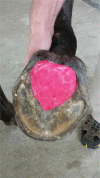The management of equine acute laminitis
- PMID: 30101095
- PMCID: PMC6067769
- DOI: 10.2147/VMRR.S39967
The management of equine acute laminitis
Abstract
Laminitis is an extremely painful condition resulting in damage to the soft tissues anchoring the third phalanx to the hoof, which can result in life-threatening debilitation. Specific therapy is not available. The most important principles of therapy include aggressive nutritional and medical management of primary disease processes, cryotherapy, anti-inflammatory therapy, pain management, and biomechanical support. This review focuses on the principles of evidenced-based therapies.
Keywords: laminitis biomechanics; laminitis pain; laminitis treatment.
Conflict of interest statement
Disclosure Dr Eades and Fugler report receiving grants from the Grayson Jockey Club Research Foundation. The authors report no other conflicts of interest in this work.
Figures


References
-
- Reilly PT, Dean EK, Orsini JA. First aid for the laminitic foot: therapeutic and mechanical support. Vet Clin North Am Equine Pract. 2010;26(2):451–458. - PubMed
-
- Geor RJ. Pasture-associated laminitis. Vet Clin North Am Equine Pract. 2009;25(1):39–50. v–vi. - PubMed
-
- Belknap JK, Black SJ. Sepsis-related laminitis. Equine Vet J. 2012;44(6):738–740. - PubMed
-
- Virgin JE, Goodrich LR, Baxter GM, Rao S. Incidence of support limb laminitis in horses treated with half limb, full limb or transfixation pin casts: a retrospective study of 113 horses (2000–2009) Equine Vet J Suppl. 2011;40(40):7–11. - PubMed
-
- Obel N. Studies on the Histopathology of Acute Laminitis. Uppsala, Sweden: Almquisst and Wiksells Boktryckeri; 1948.
Publication types
LinkOut - more resources
Full Text Sources
Other Literature Sources

